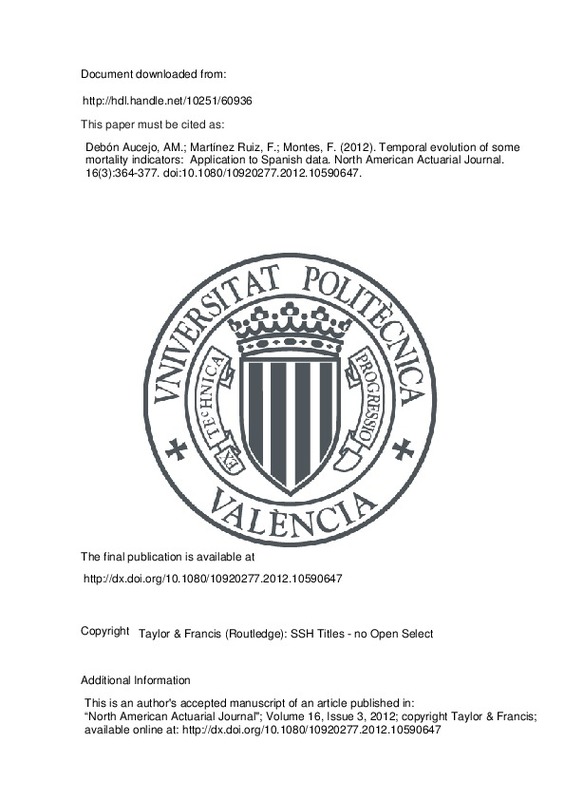JavaScript is disabled for your browser. Some features of this site may not work without it.
Buscar en RiuNet
Listar
Mi cuenta
Estadísticas
Ayuda RiuNet
Admin. UPV
Temporal evolution of some mortality indicators: Application to Spanish data
Mostrar el registro sencillo del ítem
Ficheros en el ítem
| dc.contributor.author | Debón Aucejo, Ana María
|
es_ES |
| dc.contributor.author | Martínez Ruiz, F
|
es_ES |
| dc.contributor.author | Montes, F
|
es_ES |
| dc.date.accessioned | 2016-02-16T15:20:51Z | |
| dc.date.available | 2016-02-16T15:20:51Z | |
| dc.date.issued | 2012 | |
| dc.identifier.issn | 1092-0277 | |
| dc.identifier.uri | http://hdl.handle.net/10251/60936 | |
| dc.description | This is an author's accepted manuscript of an article published in: “North American Actuarial Journal"; Volume 16, Issue 3, 2012; copyright Taylor & Francis; available online at: http://dx.doi.org/10.1080/10920277.2012.10590647 | es_ES |
| dc.description.abstract | [EN] In Spain, as in other developed countries, significant changes in mortality patterns have occurred during the 20th and 21st centuries. One reflection of these changes is life expectancy, which has improved in this period, although the robustness of this indicator prevents these changes from being of the same order as those for the probability of death. If, moreover, we bear in mind that life expectancy offers no information as to whether this improvement is the same for different age groups, it is important and necessary to turn to other mortality indicators whose past and future evolution in Spain we are going to study. These indicators are applied to Spanish mortality data for the period 1981–2008, for the age range 0–99. To study its future evolution, the mortality ratios have to be projected using an adequate methodology, namely, the Lee-Carter model. Con- fidence intervals for these predictions can be calculated using the methodology that Lee and Carter apply in their original article for expected lifetime confidence intervals, but they take into account only the error in the prediction of the mortality index obtained from the ARIMA model adjusted to its temporal series, excluding other sources of error such as that introduced by estimations of the other parameters in the model. That is why bootstrap procedures are preferred, permitting the combination of all sources of uncertainty. | es_ES |
| dc.description.sponsorship | Support for the research presented in this paper was provided by a grants from MeyC (Ministerio de Educacio´n y Ciencia, Spain), projects MTM2010-14961 and MTM2008-05152. This article was finished in two research stays at Cass Business School (London) funded by ‘‘Jose´ Castillejo’’ Program, Universitat Polite`cnica de Vale`ncia (PAID-00-12) and the Faculty de Administracio´n y Direccio´n de Empresas. We appreciate this funding and the opportunity to discuss our ideas with faculty and doctoral students Cass Business School. | |
| dc.language | Inglés | es_ES |
| dc.publisher | Taylor & Francis (Routledge): SSH Titles - no Open Select | es_ES |
| dc.relation.ispartof | North American Actuarial Journal | es_ES |
| dc.rights | Reserva de todos los derechos | es_ES |
| dc.subject | Lee-Carter model | es_ES |
| dc.subject | Mortality indicators | es_ES |
| dc.subject | Bootstrap | es_ES |
| dc.subject.classification | ESTADISTICA E INVESTIGACION OPERATIVA | es_ES |
| dc.title | Temporal evolution of some mortality indicators: Application to Spanish data | es_ES |
| dc.type | Artículo | es_ES |
| dc.identifier.doi | 10.1080/10920277.2012.10590647 | |
| dc.relation.projectID | info:eu-repo/grantAgreement/MICINN//MTM2010-14961/ES/PROBLEMAS NOTABLES EN PROCESOS ESTOCASTICOS ESPACIO-TEMPORALES/ | es_ES |
| dc.relation.projectID | info:eu-repo/grantAgreement/UPV//PAID-00-12/ | es_ES |
| dc.relation.projectID | info:eu-repo/grantAgreement/MICINN//MTM2008-05152/ES/METODOS ESTADISTICOS PARA LOS SEGUROS VIDA. APLICACION A LA HIPOTECA INVERSA/ | |
| dc.rights.accessRights | Abierto | es_ES |
| dc.contributor.affiliation | Universitat Politècnica de València. Departamento de Estadística e Investigación Operativa Aplicadas y Calidad - Departament d'Estadística i Investigació Operativa Aplicades i Qualitat | es_ES |
| dc.description.bibliographicCitation | Debón Aucejo, AM.; Martínez Ruiz, F.; Montes, F. (2012). Temporal evolution of some mortality indicators: Application to Spanish data. North American Actuarial Journal. 16(3):364-377. https://doi.org/10.1080/10920277.2012.10590647 | es_ES |
| dc.description.accrualMethod | S | es_ES |
| dc.relation.publisherversion | http://dx.doi.org/10.1080/10920277.2012.10590647 | es_ES |
| dc.description.upvformatpinicio | 364 | es_ES |
| dc.description.upvformatpfin | 377 | es_ES |
| dc.type.version | info:eu-repo/semantics/publishedVersion | es_ES |
| dc.description.volume | 16 | es_ES |
| dc.description.issue | 3 | es_ES |
| dc.relation.senia | 233719 | es_ES |
| dc.contributor.funder | Universitat Politècnica de València | |
| dc.contributor.funder | Ministerio de Ciencia e Innovación | es_ES |







![[Cerrado]](/themes/UPV/images/candado.png)

